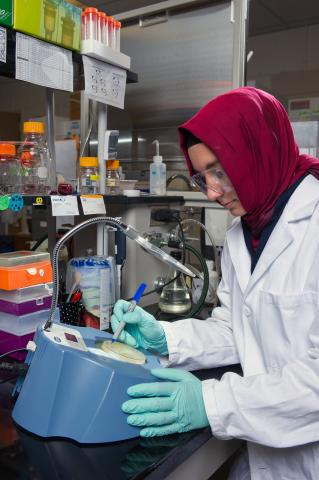event
2015 Suddath Award Winner Presentation
Primary tabs
"Transcript RNA: A New Player in Homologous Recombination and DNA Break Repair""
2015 Suddath Award Winner
Havva Keskin
Doctoral Candidate
Francesca Storici, PhD - Advisor
Transcript RNA: a new player in homologous recombination and DNA break repair A double-strand break (DSB) is a highly dangerous DNA lesion, causing cell death and mutations at the greatest rate, unless properly repaired. A major repair mechanism of DNA DSBs is homologous recombination (HR), which involves exchange of genetic information between two similar or identical DNA templates. Previously, we demonstrated that synthetic RNA-containing molecules can serve as templates for repairing defective or broken homologous chromosomal DNA in yeast, human and bacterial cells, but it remained unclear whether cellular RNA transcript can recombine with genomic DNA. Here we show that yeast cells can use transcript RNA as a template to repair a chromosomal DSB either indirectly, if the RNA is converted first into a DNA copy, cDNA, or directly. We developed a system to detect RNA templated HR following repair of a chromosomal DSB occurring either in a homologous but remote locus (in trans) or in the same transcript-generating locus (in cis) in yeast Saccharomyces cerevisiae. Initial results revealed that transcript RNA could repair the DSB only indirectly, via cDNA. Moreover, cDNA repair was much more frequent in the trans than in the cis system, likely because as soon as the DSB is induced in the cis system there cannot be transcription of the repairing RNA. When we deleted the genes coding for ribonuclease H1 and H2 (RNases H1 and H2), which cleave the RNA strand of RNA/DNA hybrid duplexes, we could detect DSB repair even in conditions that strongly inhibit cDNA formation. The repair was surprisingly, more efficient in the cis than in the trans system and was independent from the abundance of the transcript generated in trans, indicating that the vicinity of the transcript RNA to the break site in the cis system was facilitating repair. DSB repair by transcript RNA in cis was promoted by the HR protein Rad52 but not Rad51, in agreement with the demonstration that the yeast and human Rad52 protein efficiently catalyzes annealing of RNA to a DSB-like DNA end in vitro. We also found that yeast cells expressing hypomorphic mutants of RNase H2, which correspond to defects in human RNase H2 that are associated with the neuroimmunological syndrome of Aicardi Goutieres (AGS), had increased frequency of DSB repair by cDNA, significantly higher than in wild-type RNase H2 cells. These results support the idea that RNase H2-defective cells, such as those of AGS patients, could have an increased level of cDNA in the form of RNA/DNA hybrids, which could play a role in activating the immune system. Our results show that if an actively transcribed region of DNA experiences damage such as a DSB, this DNA can repair itself using either its intact transcript as template in cis, or a cDNA form of its transcript as template in trans. Our study provides proof for a new mechanism of DNA repair and HR mediated by RNA in yeast and unravels new aspects in the complex relationship between RNA and DNA in genome stability.
Havva Keskin1, Ying Shen1,2, Fei Huang3, Mikir Patel3, Taehwan Yang1, Katie Ashley1, Alexander V. Mazin3 and Francesca Storici1
1School of Biology, Georgia Institute of Technology, 310 Ferst Dr., Atlanta, GA 30332, USA.
2School of Medicine, Stanford University, Stanford, CA, 94305-5168, USA.
3Department of Biochemistry and Molecular Biology, Drexel University College of Medicine, Philadelphia, Pennsylvania, 19102, USA.
The Parker H. Petit Institute for Bioengineering & Bioscience awards the Suddath Symposium graduate student awards to three students for their grand achievements in biological or biochemical research at the molecular or cellular level. Ryan Bloomquist, advised by Todd Streelman, PhD, received the 2nd place award in 2015 for his research in dental patterning and regeneration in vertebrates, and Eli Fine, a doctoral student in the lab of Gang Bao, PhD, was recognized for a 3rd place award for his accomplishments in developing novel approaches to precisely modifying the genetic information stored in DNA.
Lunch to be served immediately following presentation.
Groups
Status
- Workflow Status:Published
- Created By:Colly Mitchell
- Created:02/03/2015
- Modified By:Fletcher Moore
- Modified:04/13/2017
Categories
Keywords
Target Audience

